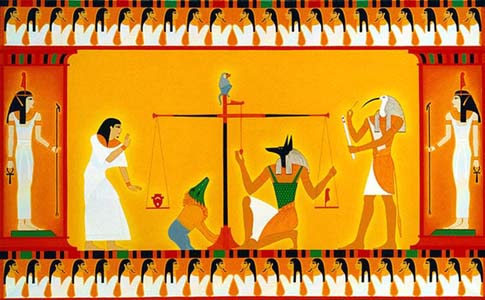

Ancient Egyptian civilization was based on religion; their belief in the rebirth after death became their driving force behind their funeral practices. Death was simply a temporary interruption, rather than complete cessation, of life, and that eternal life could be ensured by means like piety to the gods, preservation of the physical form through Mummification, and the provision of statuary and other funerary equipment. Each human consisted of the physical body, the 'ka', the 'ba', and the 'akh'. The Name and Shadow were also living entities. To enjoy the afterlife, all these elements had to be sustained and protected from harm.
Before the Old Kingdom, bodies buried in desert pits were naturally preserved by desiccation. The arid, desert conditions continued to be a boon throughout the history of ancient Egypt for the burials of the poor, who could not afford the elaborate burial preparations available to the elite. Wealthier Egyptians began to bury their dead in stone tombs and, as a result, they made use of artificial mummification, which involved removing the internal organs, wrapping the body in linen, and burying it in a rectangular stone sarcophagus or wooden coffin. Beginning in the Fourth Dynasty, some parts were preserved separately in canopic jars.
By the New Kingdom, the ancient Egyptians had perfected the art of mummification; the best technique took 70 days and involved removing the internal organs, removing the brain through the nose, and desiccating the body in a mixture of salts called natron. The body was then wrapped in linen with protective amulets inserted between layers and placed in a decorated anthropoid coffin. Mummies of the Late Period were also placed in painted cartonnage mummy cases. Actual preservation practices declined during the Ptolemaic and Roman eras, while greater emphasis was placed on the outer appearance of the mummy, which was decorated.
Wealthy Egyptians were buried with larger quantities of luxury items, but all burials, regardless of social status, included goods for the deceased. Beginning in the New Kingdom, books of the dead were included in the grave, along with shabti statues that were believed to perform manual labor for them in the afterlife Rituals in which the deceased was magically re-animated accompanied burials. After burial, living relatives were expected to occasionally bring food to the tomb and recite prayers on behalf of the deceased.
Egyptians also believed that being mummified was the only way to have an afterlife. Only if the corpse had been properly embalmed and entombed in a mastaba, could the dead live again in the Fields of Yalu and accompany the Sun on its daily ride.
Anubis is the Greek name for a jackal-headed god associated with mummification and the afterlife in Egyptian mythology. In the ancient Egyptian language, Anubis is known as Inpu, (variously spelled Anupu, Ienpw etc.). The oldest known mention of Anubis is in the Old Kingdom pyramid texts, where he is associated with the burial of the king. At this time, Anubis was the most important god of the Dead but he was replaced during the Middle Kingdom by Osiris.
Anubis takes various titles in connection with his funerary role, such as He who is upon his mountain, which underscores his importance as a protector of the deceased and their tombs, and the title He who is in the place of embalming, associating him with the process of mummification. Like many ancient Egyptian deities, Anubis assumes different roles in various contexts, and no public procession in Egypt would be conducted without an Anubis to march at the head.
In Ancient Egyptian religion, when the body died, parts of its soul known as ka (body double) and the ba (personality) would go to the Kingdom of the Dead. While the soul dwelt in the Fields of Aaru, Osiris demanded work as payback for the protection he provided. Statues were placed in the tombs to serve as substitutes for the deceased.
Arriving at one's reward in afterlife was a demanding ordeal, requiring a sin-free heart and the ability to recite the spells, passwords, and formulae of the Book of the Dead.
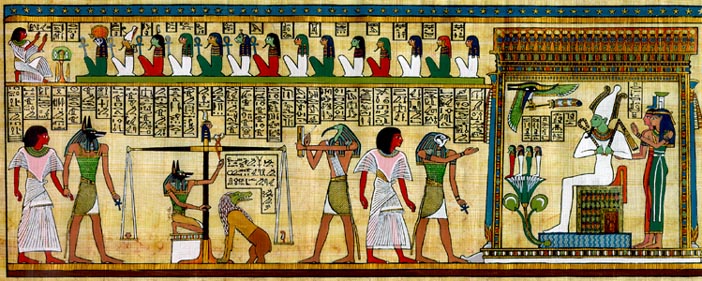
In the Hall of Two Truths, the deceased's heart was weighed against the Shu feather of truth and justice taken from the headdress of the goddess Ma'at. If the heart was lighter than the feather, they could pass on, but if it were heavier they would be devoured by the demon Ammut. This scene depicts what occurs after a person has died, according to the ancient Egyptians.
Beginning with the upper left-hand corner, the deceased appears before a panel of 14 judges to make an accounting for his deeds during life. The ankh, the key of life, appears in the hands of some of the judges.
Next, below, the jackal god Anubis who represents the underworld and mummification leads the deceased before the scale. In his hand, Anubis holds the ankh.
Anubis then weighs the heart of the deceased (left tray) against the feather of Ma'at, goddess of truth and justice (right tray). In some drawings, the full goddess Ma'at, not just her feather, is shown seated on the tray. Note that Ma'at's head, crowned by the feather, also appears atop the fulcrum of the scale. If the heart of the deceased outweighs the feather, then the deceased has a heart which has been made heavy with evil deeds. In that event, Ammut the god with the crocodile head and hippopotamus legs will devour the heart, condemning the deceased to oblivion for eternity. But if the feather outweighs the heart, and then the deceased has led a righteous life and may be presented before Osiris to join the afterlife. Thoth, the ibis-headed god of wisdom stands at the ready to record the outcome.
Horus, the god with the falcon head, then leads the deceased to Osiris. Note the ankh in Horus' hand. Horus represents the personification of the Pharaoh during life, and his father Osiris represents the personification of the Pharaoh after death.
Osiris, lord of the underworld, sits on his throne, represented as a mummy. On his head is the white crown of Lower Egypt (the north). He holds the symbols of Egyptian kingship in his hands: the shepherd's crook to symbolize his role as shepherd of mankind, and the flail, to represent his ability to separate the wheat from the chaff. Behind him stand his wife Isis and her sister Nephthys. Isis is the one in red, and Nephthys is the one in green. Together, Osiris, Isis, and Nephthys welcome the deceased to the underworld.
The tomb-owner would continue after death the occupations of this life and so everything required was packed in the tomb along with the body. Writing materials were often supplied along with clothing, wigs, and hairdressing supplies and assorted tools,depending on the occupation of the deceased.
Often model tools rather than full size ones would be placed in the tomb; models were cheaper and took up less space and in the after-life would be magically transformed into the real thing. Things might include a headrest, glass vessels which may have contained perfume and a slate palette for grinding make-up.
Food was provided for the deceased and should the expected regular offerings of the descendants cease, food depicted on the walls of the tomb would be magically transformed to supply the needs of the dead.
Images on tombs might include a triangular shaped piece of bread (part of the food offerings from a tomb). Other images might represent food items that the tomb owner would have eaten in his lifetime and hoped to eat in the after-life.
Life was dominated by Ma'at, or the concept of justice and order. Egyptians believed there were different levels of goodness and evil. Egyptians believed that part of the personality, called the Ka, remained in the tomb. Thus elaborate and complex burial practices developed.
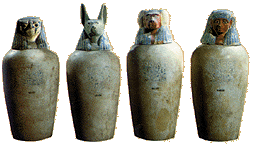
The removed internal organs were separately treated and, during much of Egyptian history, placed in jars of clay or stone. These so-called Canopic Jars were closed with stoppers fashioned in the shape of four heads -- human, baboon, falcon, and jackal - representing the four protective spirits called the Four Sons of Horus.
The heart was removed to be weighed against a feather representing Ma'at to determine moral righteousness. The brain was sucked out of the cranial cavity and thrown away because the Egyptian's thought it was useless. Personal belongings were usually placed in the tomb to make the Ka more at home and to assist the dead in their journey into the afterlife.
Text was read from the 'Book of the Dead' and the ritual of "openingthe mouth" was performed before the tomb was sealed.
Much of what we know about art and life in ancient Egypt has been preserved in the tombs that were prepared for the protection of the dead. The Egyptians believed that the next life had to be provided for in every detail and, as a result, tombs were decorated with depictions of the deceased at his funerary meal, activities of the estate and countryside, and the abundant offerings necessary to sustain the spirit.
Many surviving Egyptian works of art were created to be placed in the tombs of officials and their families. Through the ritual of "opening the mouth," a statue of the deceased (known as a "ka statue") was thought to become a living repository of a person's spirit. Wall paintings, reliefs, and models depict pleasurable pastimes and occupations of daily life. Always these images have deeper meanings of magical protection, sustenance, and rebirth. The mummy was surrounded with magic spells, amulets, and representations of protective deities.
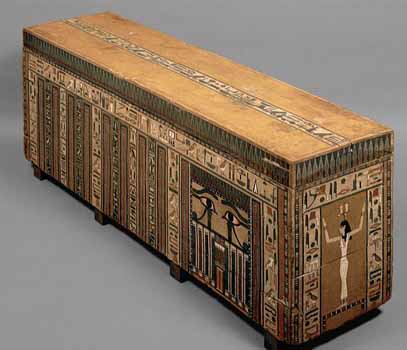
At the near end of the coffin a goddess stands, her arms raised protectively. The hieroglyphic inscriptions are magical requests for offerings and protection. Small magical amulets made of semiprecious stones or faience were placed within the linen wrappings of the mummy. Many of them were hieroglyphic signs.
For Egyptians, the cycles of human life, rebirth, and afterlife mirrored the reproductive cycles that surrounded them in the natural world. After death, the Egyptians looked forward to continuing their daily lives as an invisible spirit among their descendents on Earth in Egypt, enjoying all the pleasures of life with none of its pain or hardships. This vision is vividly depicted in the sculptures, reliefs, and wall paintings of Egyptian tombs, with the deceased portrayed in the way he or she wished to remain forever accompanied by images of family and servants. These forms of art not only reflect the Egyptians' love of life but also by their very presence made the afterlife a reality.
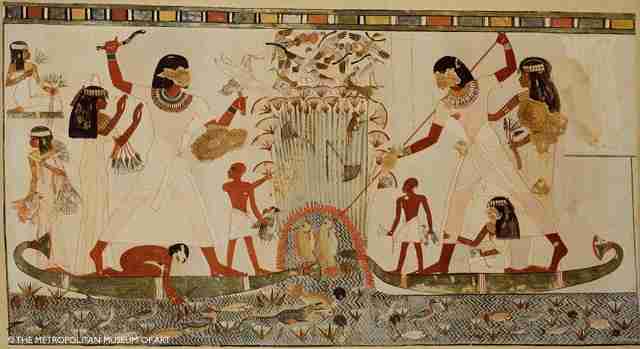
The Egyptians believed that the pleasures of life could be made permanent through scenes like this one of Menna hunting in the Nile marshes. In this painting Menna, the largest figure, is shown twice. He is spear fishing on the right and flinging throwing sticks at birds on the left. His wife, the second-largest figure, and his daughter and son are with him. By their gestures they assist him and express their affection. The son on the left is drawing attention with a pointed finger to the two little predators (a cat and an ichneumon) that are about to steal the birds' eggs. Pointed fingers were a magical gesture for averting evil in ancient Egypt, and the attack on the nest may well be a reminder of the vulnerability of life.
Overall, scenes of life in the marshes, which were depicted in many New Kingdom tombs, also had a deeper meaning. The Nile marshes growing out of the fertile mud of the river and the abundant wildlife supported by that environment symbolized rejuvenation and eternal life.
The figures in Menna's family are ordered within two horizontal rows, or registers, and face toward the center in nearly identical groups that fit within a triangular shape.
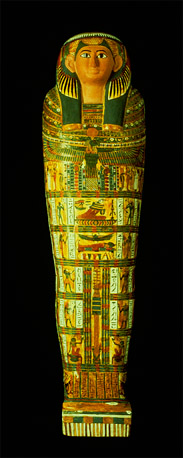
The mummy was placed in a brightly painted wooden coffin. The elaborate decoration on Nes-mut-aat-neru's coffin fits her status as a member of the aristocracy. A central band contains symbols of rebirth flanked by panels featuring images of god and goddesses. Look for the central panel that shows the winged scarab beetle hovering protectively over the mummy (probably meant to represent the mummy of the Nes-mut-aat-neru herself).
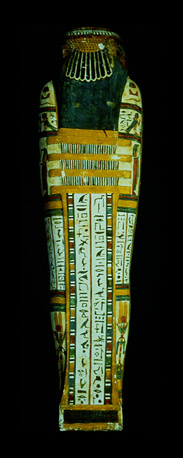
The large white pillar painted on the back of the coffin forms a "backbone." This provides symbolic support for the mummy and displays an inscription detailing Nes-mut-aat-neru's ancestry
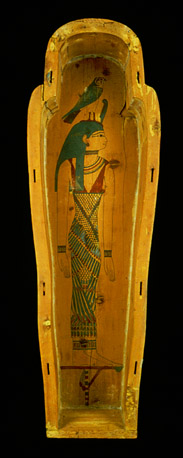
Next the mummy and coffin were placed in another wooden coffin. Like the first coffin, it is in the shape of the mummy but more simply decorated. The inside of the base is painted with a full-length figure of a goddess.
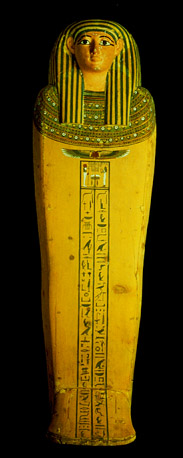
The lid again shows Nes-mut-aat-neru's face, wig and elaborate collar. Here too the scarab beetle with outstretched wings hovers over the mummy. Below the scarab look for a small scene showing the deceased Nes-mut-aat-neru worshipping a god, and a two-column inscription.
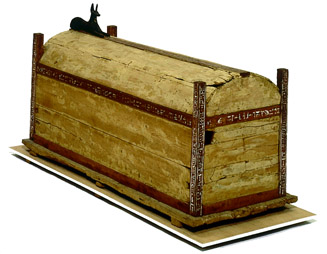
Finally the mummy and coffins were placed in a rectangular outermost coffin made primarily out of sycamore wood. The posts of the coffin are inscribed with religious texts. On the top of the coffin sits an alert jackal, probably a reference to Anubis, the jackal-headed god who was the patron of embalmers and protector of cemeteries.
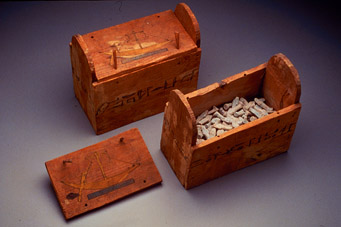
These two wooden boxes filled with mud shawabti figures were found with Nes-mut-aat-neru's elaborate nested coffins. Shawabti figures were molded in the shape of a mummified person, and were designed to do any work that the gods asked the deceased's spirit to do in the afterworld.
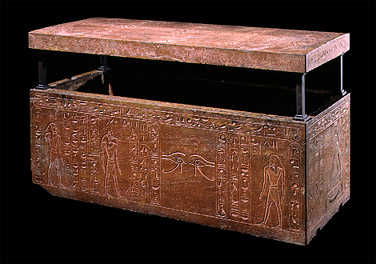
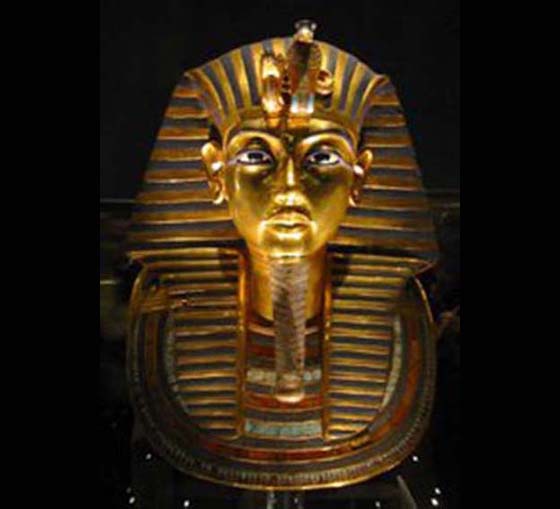
Masks of deceased persons are part of traditions in many countries. The most important process of the funeral ceremony in ancient Egypt was the mummification of the body, which, after prayers and consecration, was put into a sarcophagus enameled and decorated with gold and gems. A special element of the rite was a sculpted mask, put on the face of the deceased. This mask was believed to strengthen the spirit of the mummy and guard the soul from evil spirits on its way to the afterworld.
The best known mask is that of Tutankhamun now in the Egyptian Antiquities Museum in Cairo. Made of gold and gems, the mask conveys the features of the ancient ruler. Most funerary masks were not made of solid gold, however, living persons in ancient Egypt might have employed transformational spells to assume nonhuman forms. These masks were not made from casts of the features; rather, the mummification process itself preserved the features of the deceased.
Masks were a very important aspect of Ancient Egyptian burials. In common with the anthropoid coffin they provided the dead with a face in the afterlife. In addition they also enabled the spirit to recognize the body.
Masked priests, priestesses or magicians, disguising themselves as divine beings, such as Anubis or Beset, almost assuredly assumed such identities to exert the powers associated with those deities. Funerary masks and other facial coverings for mummies emphasized the ancient
Egyptian belief in the fragile state of transition that the dead would have to successfully transcend in their physical and spiritual journey from this world to their divine transformation in the next. Hence, whether worn by the living or the dead, masks played a similar role of magically transforming an individual from a mortal to a divine state.
On various artifacts, we find numerous examples in art, beginning with the Predynastic palettes (such as the Two-Dog palette), representations of anthropomorphic beings with the heads of animals, birds or other fantastic creatures. Some of these are understood to have probably been humans dressed as deities, though the ancient Egyptians probably saw them as images or manifestations of the gods themselves. This was probably most evident in three dimensional representations such as the Middle Kingdom female figure from Western Thebes (modern Luxor), now in the collection of the Manchester Museum and sometimes referred to in earlier texts as a leonine-masked human. Though most certainly a human dressed as an animal, this figure was surely considered an image of Beset.
Two dimensional depictions are more difficult to interpret. The question of the extent to which these depicted masks were used in Egyptian religious rituals has not yet been satisfactorily resolved for all periods of ancient Egyptian history. This may be due to intentional ambiguity. An example is one very common depiction rendered in many mortuary scenes that records the mummification of a body by a jackal-headed being.
Such representations may document the actual mummification rites performed by a jackal-disguised priest, though it may also be interpreted as commemorating that episode of the embalmment by the jackal god Anubis in the mythic account of the death and resurrection of the god of the dead, Osiris, whom the deceased wished to emulate.
Another example is a ritual procession of composite animal and human figures, identified in the accompanying texts, as the souls of Nekhen and Pe, who carry the sacred bark in a procession detailed on the southwestern interior wall of the Hypostyle Hall in the Temple of Amun at Karnak.
Scenes such as this may either be literal records of the historic celebration performed by masked or costumed priests, or alternatively they may represent a visual actualization of faith in the royal dogma, which claimed categorically that the mythic ancestors of the god-king legitimized and supported his reign.
It is thought that the ancient Egyptians did in fact perform some ritual ceremonies wearing such masks, though these ritual objects from the archaeological record are rare. Perhaps this is due to the fragile and perishable materials from which such masks may have been constructed (though surely some were made from gold, thought to be the skin of the gods).
We do have an example of a fragmentary Middle Kingdom Bes-like or Aha (perhaps an ancient god and forerunner of Bes) face of cartonnage recovered by W.M. Flinders Petrie at the town site of Kahun. However, this relic may not have been a mask even though it does appear to have eye holes.
There was also an unusual set of late Middle Kingdom objects found in shaft-tomb 5 under the Ramesseum that included a wooden figurine representing either a lion-headed goddess or a woman wearing a similar kind of mask, which probably connected in some way with the performance of magic.
However, the only incontrovertible evidence for the use of ritual masks by the living are found from Egypt's Late Period. From that time, for example, we have a unique, ceramic mask of the head of the jackal god, Anubis (now in the collection of the Roemer Pelizaeus- Museum, Hildesheim), dating to sometime after 600 BC, which was apparently manufactured specifically as a head covering.
This mask has indentations on both sides which would have allowed it to be supported atop the shoulders. The snout and upraised ears of the jackal head would have surmounted the wearers actual head. Two holes in the neck of the object would have allowed the wearer to view straight ahead. However, lateral vision would have been limited, thus necessitating the wearer's need for assistance, as explicitly depicted in a temple relief at Dendera. In this depiction, the priest wears just such a mask, and is assisted by a companion priest. A description of a festival procession of Isis, which was led by the god Anubis, who was presumably a similarly masked priest, took place not in Egypt but rather in Kenchreai.
Funerary masks had more than one purpose. They were a part of the elaborate precautions taken by the ancient Egyptians to preserve the body after death. The protection of the head was of primary concern during this process. Thus, a face covering helped preserve the head, as well as providing a permanent substitute, in an idealized form which presented the deceased in the likeness of an immortal being, in case of physical damage. Those of means were provided with both a mask with gilt flesh tones and blue wigs, both associated with the glittering flesh and the lapis lazuli hair of the sun god.
Specific features of a mask, including the eyes, eyebrows, forehead and other features, were directly identified with individual divinities, as explained in the Book of the Dead, Spell 151b. This allowed the deceased to arrive safely in the hereafter, and gain acceptance among the other divine immortals in the council of the great god of the dead, Osiris. Though such masks were initially made for only the royalty, later such masks were manufactured for the elite class for both males and females. Beginning in the 4th Dynasty, attempts were made to stiffen and mold the outer layer of linen bandages used in mummification to cover the faces of the deceased and to emphasize prominent facial features in paint.
The forerunners of mummy masks date to this period through the 6th Dynasty, taking the form of thin coatings of plaster molded either directly over the face or on top of the linen wrappings, perhaps fulfilling a similar purpose to the 4th Dynasty reserve heads. A plaster mold, apparently taken directly from the face of a corpse, was excavated from the 6th Dynasty mortuary temple of Teti, though unfortunately, this is thought to date to the Greco-Roman period.
The very earliest masks were experimentally crafted as independent sculptural work, and have been dated to the Herakleopolitan period (late First Intermediate Period). These early masks were made of wood, fashioned in two pieces and held together with pegs, or cartonnage (layers of linen or papyrus stiffened with plaster. They were molded over a wooden model or core.
The masks of both men and women had over-exaggerated eyes and often enigmatic half smiles. These objects were then framed by long, narrow, tripartite wigs held securely by a decorated headband.
The "bib" of the mask extended to cover the chest, and were painted for both males and females with elaborate beading and floral motif necklaces or broad collars that served not only an aesthetic function but also an apotropaic requirement as set out in the funerary spells.
Hollow and solid masks (sometimes of diminutive size) were also built by pouring clay or plaster into generic, often unisex molds. To this, ears and gender specific details were than added. These elongated masks eventually evolved into anthropoid inner coffins, first appearing in the 12th Dynasty.
Masks became increasingly more sophisticated during the New Kingdom and Third Intermediate Period. These later masks made for royalty were beaten from precious metals. Of course, an obvious example of such is the solid gold mask of Tutankhamun, though we also have fine gold and silver specimens from Tanis.
However, masks of all types were embellished with paint, using red for the flesh tones of males and yellow, pale tones for females. Added to this were composite, inlaid eyes or eyebrows, as well as other details that could elevate the cost of the finished product considerably. Hence, indications of social status, including hairstyles, jewelry and costumes (depicted on body-length head covers) are often helpful in dating masks. However, the idealized image of transfigured divinity, which was the objective of the funerary masks, precluded the individualization of masks to the point of portraiture. The results are that we have a relative sameness in these objects with anonymous facial features from all periods of Egyptian history.
The use of face coverings for the dead continued in Egypt for as long as mummification was practiced in Egypt. Regional preferences included cartonnage and plaster masks, both of equal popularity during the Ptolemaic (Greek) period. The cartonnage masks became actually only one part of a complete set of separate cartonnage pieces that covered the wrapped body. This set included a separate cartonnage breastplate and foot case. During the Roman period, plaster masks exhibit Greco-Roman influence only in their coiffures, which were patterned from styles current at the imperial court. This included both beards and mustaches for males, and elaborate coiffures on women, all highly molded in relief.
However, during the Roman period there were alternatives to the cartonnage or plaster mask. Introduced during this period were the so-called Fayoum portraits, which were initially unearthed from cemeteries in the Fayoum and first archaeologically excavated in 1888 and between 1910 and 1911 by Flinders Petrie at Hawara.
Since then, they have been discovered at sites throughout Egypt from the northern coast to Aswan in the south. These were paintings made with encaustic (colored beeswax) or tempera (watercolor) on wooden panels or linen shrouds and were rendered in a Hellenistic style not unlike contemporary frescoes discovered at Pompeii and Herculaneum in Italy. Nevertheless, it is believed that such two-dimensional paintings held the same ideological function as traditional three-dimensional masks.
However, these portraits were popular among nineteenth and early twentieth century collectors and this had a tendency to at first isolate them from their funerary contexts. They were studied by classicists and art historians who, basing their conclusions on details in the paintings along, such as hairstyles, jewelry and costume, identified the portraits as being those of Greek or Roman settlers who had adopted Egyptian burial customs. In fact, successful attempts have been made, based on the analysis of brush strokes and tool marks and the distinctive rendering of anatomical features, to group these portraits according to schools and to identify some individual artistic hands.
However, though the portraits do appear at first to capture the unique features of specific individuals, it appears likely that only the earliest examples were painted from live models. Studies have indicated that the same generic quality that permeates the visages of the cartonnage and plaster masks persists within the group of Fayoum portraits that have been preserved and therefore we believe that they served in a similar fashion as the earlier masks.
There may also be evidence for a cultic use of these paintings while their owners still lived. The fact that the upper corners of some of these panels were cut at an angle to secure a better fit before being positioned over the mummy, that there are signs of wear on paintings in places that would have been covered by the mummy wrappings, and that at least one portrait (now in the British Museum was discovered at Hawara still within a wooden frame indicates that the paintings had a domestic use prior to inclusion within the funerary equipment. They may have been hung in the owners home prior to such use.
Yet the iconographic elements, including gilded lips in accordance with the funerary spells 21 through 23 of the Book of the Dead to insure the power of speech during the afterlife, as well as the allusions to traditional deities, such as the sidelock of Horus worn by adolescents, the pointed star diadem of Serapis worn by men, and the horned solar crown of Isis worn by adult females, together with other evidence, emphasize a continuity of native Egyptian traditions. Though the product of the Hellenistic age of Roman Egypt, they date from the end of a continuum of a desire to permanently preserve the faces of the dead in an idealized and transfigured form that began in the Old Kingdom and lasted to the end of pagan Egypt.
The last examples we have of funerary masks are actually painted linen shrouds of which the upper part was pressed into a mold to produce the effect of a three dimensional plaster mask. Some examples of this type of object may date as late as the third of fourth century AD. First unearthed by Edouard Naville within the sacred precinct of the mortuary chapel of Queen Hatshepsut, they were initially and incorrectly identified by him as the mummies of early Christians. However, later analysis by H. E. Winlock, particularly noting the ubiquitous representation of the bark of the Egyptian funerary god Sokar, correctly identified these as further examples of masks consistent with pagan Egyptian funerary traditions, even though certain motifs, such as the cup held in one hand, seem to present the final transition from pagan mask to Coptic icon painting and the portraits of Byzantine saints.
Egyptian funerary art was inseparably connected to the belief that life continues after death and that in order to make the journey between this and the next, images and memorabilia should be preserved. The Valley of the Kings was built as a necropolis for royal and elite tombs from about 1500 BCE, while the Theban Necropolis was later an important site for Mortuary temples and mastaba tombs. Individual portraiture of the deceased is found extremely early on.
The intention was to commemorate the life of the tomb owner, provide supplies necessary for the afterlife, depict performance of the burial rites, and in general present an environment that would be conducive to the tomb owner's rebirth. There is a special category of Ancient Egyptian funerary texts, which clarify the purposes of the burial customs. The Egyptian mummy, encased in one or more layers of coffin, is famous; the Canopic jars contained several internal organs.
Lower citizens used common forms of funerary art including shabti figurines (to perform any labor that might be required of the dead person in the afterlife), models of the scarab beetle and books of the dead which they believed would protect them in the afterlife During the Egyptian Middle Kingdom, miniature wooden or clay models depicting scenes from everyday life became popular additions to the tomb. In an attempt to duplicate the activities of the living in the afterlife, these models show laborers, houses, boats, and even military formations which are scale representations of the ideal ancient Egyptian afterlife.

Mummification
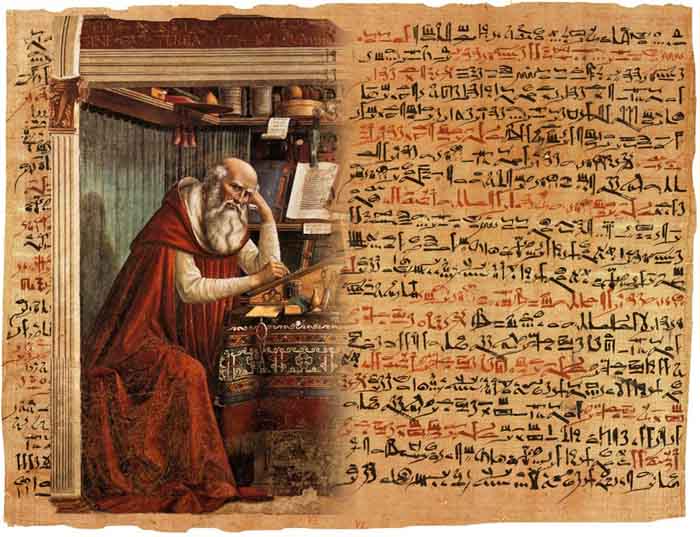
Ancient Egyptian Medicine
Various Egyptian Papyri
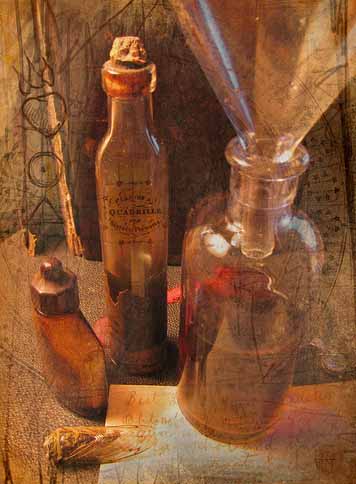
Alchemy
ANCIENT AND LOST CIVILIZATIONS